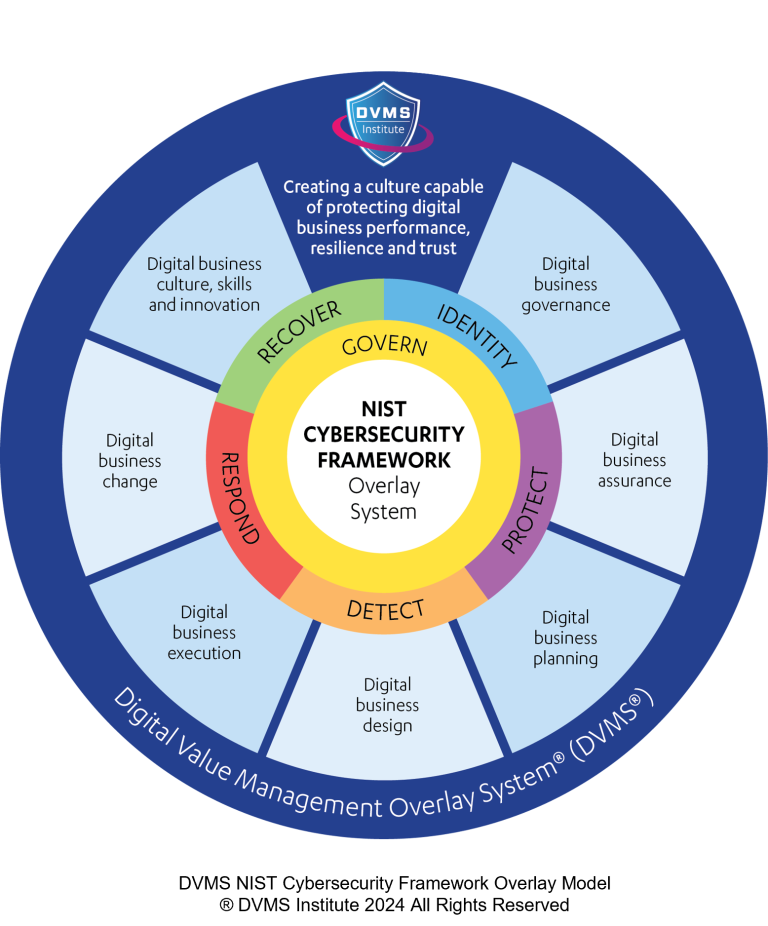Why Building an Internal Cyber Risk & Resilience Training and Mentoring Team is an Operational Necessity
Rick Lemieux – Co-Founder and Chief Product Officer of the DVMS Institute
In today’s interconnected and technology-driven world, organizations of all sizes and complexities face an ever-growing landscape of digital risks.
The rise of cyber threats, regulatory compliance demands, and the increasing reliance on digital systems for operational efficiency underscore the need for businesses to be proactive in safeguarding their digital assets. Establishing an internal organization dedicated to training and mentoring employees on identifying, classifying, and mitigating digital risks is not just a strategic advantage, but an operational necessity. Such initiatives help protect the organization’s digital value, bolster resilience, and maintain client trust, which are crucial for long-term sustainability and growth.
Digital risk is a multifaceted challenge encompassing cybersecurity threats, data privacy concerns, regulatory compliance issues, and operational vulnerabilities. As businesses continue to digitize operations, adopt cloud-based technologies, and embrace remote work, their exposure to these risks grows exponentially. Cybercriminals exploit vulnerabilities in networks, applications, and human behavior, targeting organizations for financial gain, espionage, or disruption. A breach or incident can lead to substantial financial losses, legal penalties, reputational damage, and erosion of client trust. For organizations to defend against these threats effectively, they must prioritize education and awareness at all levels of the organization.
Training programs embedded within an internal organization are critical because they foster a culture of vigilance and accountability. Employees are often in the first line of defense against digital risks, as human error remains one of the primary causes of breaches. Phishing emails, weak passwords, and mishandling of sensitive data are common entry points for attackers. By educating employees on recognizing and responding to potential threats, organizations can significantly reduce their vulnerability. A well-trained workforce is more likely to spot suspicious activities, report them promptly, and adhere to best practices for maintaining cybersecurity.
The classification of digital risks is another essential component of an effective risk management strategy. Not all threats are created equal; their potential impact and likelihood vary widely. An internal organization dedicated to digital risk management can provide tailored training to help employees understand the hierarchy of risks and the importance of prioritization. For instance, risks that could compromise critical infrastructure or client data may warrant immediate attention, while others, such as less severe software vulnerabilities, might be addressed over time. This approach ensures that resources are allocated effectively and that the most significant threats are mitigated promptly.
Mitigating digital risks requires a comprehensive, multi-layered approach that combines technology, processes, and human expertise. An internal organization focused on digital risk management serves as a central hub for developing, implementing, and refining these strategies. It can conduct regular risk assessments, simulate attack scenarios, and evaluate the effectiveness of existing controls. Moreover, it can adapt training content to reflect emerging threats and industry best practices. For example, employees can be trained in how to respond to ransomware attacks, implement secure coding practices, or ensure compliance with data protection regulations like GDPR or CCPA.
Beyond technical defenses, an internal training organization plays a pivotal role in fostering a culture of resilience. Resilience involves not just preventing incidents but also ensuring that the organization can recover quickly and effectively when they occur. Employees trained in incident response protocols are better equipped to contain and remediate breaches, minimizing downtime and operational disruption. Furthermore, resilience training emphasizes the importance of adaptability and continuous learning, enabling the organization to stay ahead of evolving threats.
Client trust is a cornerstone of any successful business, and safeguarding digital assets is integral to maintaining this trust. Clients expect organizations to protect their sensitive information and uphold the integrity of their interactions. A single breach can irreparably damage this trust, leading to customer attrition and negative publicity. By investing in a robust internal organization to train employees on digital risk management, organizations signal their commitment to security and reliability. This proactive stance not only reassures clients but also enhances the organization’s reputation as a responsible and forward-thinking entity.
Smaller organizations might assume that their limited size exempts them from being targeted by cybercriminals, but this is a dangerous misconception. Attackers often view small and medium-sized enterprises (SMEs) as low-hanging fruit due to their perceived lack of robust defenses. For these organizations, establishing an internal training organization need not be a resource-intensive endeavor. Instead, they can leverage scalable solutions such as online training modules, third-party consultants, and industry partnerships to build a strong foundation for digital risk management. Even a modest investment in training can yield significant returns by preventing costly incidents and ensuring business continuity.
Large and complex organizations, on the other hand, face the challenge of managing digital risks across diverse operations, geographies, and systems. For them, an internal training organization must be highly structured and integrated into broader enterprise risk management frameworks. These organizations benefit from advanced training programs that address the unique challenges of scale, such as securing supply chains, managing third-party risks, and implementing consistent policies across global operations. Centralizing the training function ensures that all employees, regardless of location or role, receive the same high-quality education and guidance.
Another advantage of an internal training organization is its ability to align digital risk management with the organization’s overall strategic goals. By collaborating with leadership, IT, legal, and compliance teams, the training organization can ensure that risk mitigation efforts support business objectives rather than hinder them. For instance, while implementing stringent security measures is critical, these measures must also facilitate rather than impede innovation and operational efficiency. A well-balanced approach allows organizations to achieve growth and transformation while maintaining a secure digital environment.
The dynamic nature of the digital landscape necessitates ongoing training and adaptability. Threats evolve, and new technologies bring both opportunities and risks. An internal organization dedicated to digital risk management is uniquely positioned to keep pace with these changes. It can monitor emerging trends, incorporate them into training programs, and disseminate updates across the organization. For example, as artificial intelligence and machine learning become more prevalent, employees must understand their implications for cybersecurity and ethical use.
Organizations of all sizes, scales, and complexities must recognize the imperative of establishing an internal organization to train and mentor employees on identifying, classifying, and mitigating digital risks. Such initiatives are essential for protecting digital value, enhancing organizational resilience, and maintaining client trust. By fostering a culture of awareness, prioritization, and adaptability, these organizations can navigate the complexities of the digital age with confidence and agility. In doing so, they not only safeguard their assets and reputation but also position themselves as leaders in an increasingly competitive and interconnected world.
About the Author

Rick Lemieux
Co-Founder and Chief Product Officer of the DVMS Institute
DVMS Institute is a renowned provider of accredited (APMG International), Assured (NCSC-GCHQ-UK), and Recognized (DHS-CISA-NICCS) NIST Cybersecurity Framework, certification training programs designed to teach organizations of any size, scale, or complexity how to manage their organizational cyber risk and resiliency.
For cyber risk management, the DVMS FastTrack model provides a phased approach to adapting the NIST Cybersecurity Framework functions and its controls across an enterprise and its supply chain to identify and mitigate organizational cyber risks.
For cyber resilience management, the DVMS CPD overlay model provides a holistic approach to connecting digital ecosystem outcomes to organizational culture. This unique approach puts leadership and culture at the center of delivering continuous digital business quality, reliability, and trust.
Rick has 40+ years of passion and experience creating solutions to give organizations a competitive edge in their service markets. In 2015, Rick was identified as one of the top five IT Entrepreneurs in the State of Rhode Island by the TECH 10 awards for developing innovative training and mentoring solutions for boards, senior executives, and operational stakeholders.
® DVMS Institute 2024 All Rights Reserved




